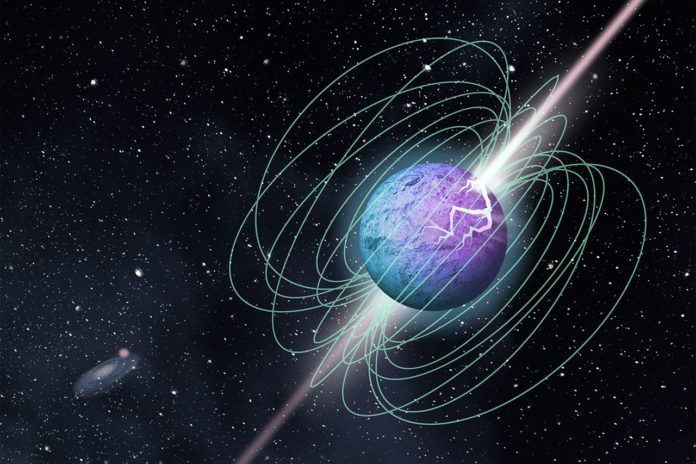Fast radio bursts, or FRBs, are intense pulses of radio waves that can emit more energy in a few thousandths of a second. Since fast radio bursts are rare and bright — they are visible from millions or even billions of light-years across space.
Many FRBs have been detected, but their origins remain poorly understood.
A flash of luck helped astronomers solve this cosmic mystery.
This April, two very different telescopes spotted a rare but considerably weaker burst from inside our own Milky Way galaxy. Those two telescopes: one a California doctoral student’s set of handmade antenna s, which included actual cake pans, the other a $20 million Canadian observatory.
They tracked that fast radio burst to a magnetar that’s 32,000 light-years from Earth. It was the first FRB traced to a source- emanating from our galaxy.
Astronomers noted, “there could be other sources for these bursts, but they are now sure about one guilty party: magnetars.”
Magnetars are a variety of neutron stars with powerful magnetic fields. A typical magnetar magnetic field is a trillion times stronger than the Earth’s magnetic field, making magnetars the most magnetic objects in the Universe. They can discharge intense bursts of X-rays and gamma rays and recently have become a leading candidate for the sources of FRBs.
Cornell University Shami Chatterjee, who wasn’t part of either discovery team, said, “There are maybe a dozen or so of these magnetars in our galaxy, apparently because they are so young and part of the star birth process and the Milky Way is not as flush with star births as other galaxies.”
Caltech radio astronomer Christopher Bochenek said, “This burst in less than a second contained about the same amount of energy that our sun produces in a month, and still that’s far weaker than the radio bursts detected coming from outside our galaxy.”
Co-author Daniele Michilli, an astrophysicist at McGill and part of the Canadian team, said, “The ones that come from outside our galaxy and travel millions or billions of light-years are “tens of thousands to millions of times more powerful than anything we have detected in our galaxy.”
Cornell’s Chatterjee said, “You had to be looking at the right place at the right millisecond. Unless you were very, very lucky, you’re not going to see one of these.”
The occurrence of FRBs outside the milky way is frequent, but astronomers don’t have any idea how often these bursts happen inside our galaxy.
Bochenek said, “We still don’t know how lucky we got. This could be a once-in-five-year thing, or there could be a few events to happen each year.”
Astronomers have had as many 50 different theories for what causes these fast radio bursts, including aliens. They emphasize that magnetars may not be the only answer, especially since there seem to be two types of fast radio bursts. Some, like the one spotted in April, happen only once, while others repeat themselves often.
Michilli said his team had traced one outburst that happens every 16 days to a nearby galaxy and is getting close to pinpointing the source.
Cornell’s Chatterjee said, “Some of these young magnetars are only a few decades old, “and that’s what gives them enough energy to produce repeating fast radio bursts.”
Journal References:
- A bright millisecond-duration radio burst from a Galactic magnetar, Nature (2020). DOI: 10.1038/s41586-020-2863-y
- A fast radio burst associated with a Galactic magnetar, Nature (2020). DOI: 10.1038/s41586-020-2872-x
- No pulsed radio emission during a bursting phase of a Galactic magnetar, Nature (2020). DOI: 10.1038/s41586-020-2872-x
- The physical mechanisms of fast radio bursts, Nature (2020). DOI: 10.1038/s41586-020-2872-x
